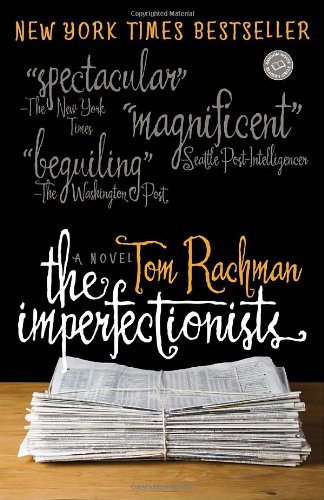All Nonfiction
- Bullying
- Books
- Academic
- Author Interviews
- Celebrity interviews
- College Articles
- College Essays
- Educator of the Year
- Heroes
- Interviews
- Memoir
- Personal Experience
- Sports
- Travel & Culture
All Opinions
- Bullying
- Current Events / Politics
- Discrimination
- Drugs / Alcohol / Smoking
- Entertainment / Celebrities
- Environment
- Love / Relationships
- Movies / Music / TV
- Pop Culture / Trends
- School / College
- Social Issues / Civics
- Spirituality / Religion
- Sports / Hobbies
All Hot Topics
- Bullying
- Community Service
- Environment
- Health
- Letters to the Editor
- Pride & Prejudice
- What Matters
- Back
Summer Guide
- Program Links
- Program Reviews
- Back
College Guide
- College Links
- College Reviews
- College Essays
- College Articles
- Back
the imperfectionists by Tom Rachman
You read the newspaper every day, with articles about global issues and what concerns you. You wait and wait, anticipating something brilliant. But have you ever wondered who constructs the paper while you stand there in your bathrobe, waiting for your dog to fetch the morning paper?
This debut novel, the imperfectionists, is by Tom Rachman, a London-born journalist. Rachman has been a foreign correspondent for the Associated Press and an editor for the International Herald Tribune in Paris. His job has taken him all over the globe exposing him to the life of journalism. That is why all the trials and tribulations that his characters go through, must have been all too familiar. Once working at the actual setting of the book, Rachman’s insight on Rome helped make this book page turner. His close attention to detail and insight on Rome assures you this isn’t an amateur who just got notes off Wikipedia. “Their walks take them all around the city. To the Botanical Gardens on the slopes of the Janiculum. To the Valle dei Cani in Villa Borghese. To the parched turf of the Circus Maximus, where tourists trudge the ancient chariot circuit,chugging bottled water.” (251)
Each chapter begins with a new person, their job and a witty title. Rachman’s endings for each chapter will leave you wanting more, whether it was because of their dramatics or composure of twists and turns. In this novel, Rachman takes you behind the bylines, and brings a story with dynamic characters that are all connected to a fatalistic idea.
The titles will first trigger your interest in wanting to know what the chapter could be about. One of the best examples of this writing technique is the Cairo stringer’s title: “The Sex Lives of Islamic Extremists.” Not only are the titles filled with wit, but they make sense once reading the chapter. The detailed writing and distinctive characters are what make each chapter worth reading. You are exposed to each reporter outside the cubicles they spend hibernating in all day, and dive into their topsy-turvy private lives. Eventually it becomes clear: the line between a private life and work is very thin. “Weird having my private life pop up when I’m in my professional mode.” (105)
Kathleen, Editor-in-Chief, tries to collect herself after the discovery of her husband’s extracurricular activity. But with an old flame rekindling and being the boss, she is a blackberry buzz away from losing it: “In the coming days, she is rude to the interns-always a litmus test of her mood-and seeks confrontations with reporters, then batters them.” (119) Ambitious and heartbroken, Kathleen is surely one of the most dynamic characters in the novel. You will laugh at her wit and cry at her grief, all in the same chapter.
“They can’t accept that she’s young and a women and above them in the food chain,” (229) is the best way to describe Abby Pinnola’s position at the paper. Sadly, the idea of being on top isn’t what Abbey thought it to be. She ends up as the battered and underappreciated financial officer, a.k.a “Accounts Payable.” The clear and utter disrespect her colleagues, or as Abbey would refer to them “glorified stenographers” have for her is exploited throughout the chapter. As faith would have it, Abbey’s already dysfunctional love life intertwines in the most unexpected way.
Guys you’re not off the hook. The book isn’t a feminist’s rant; in fact the women have the hard shell. One of the most emotional characters is the freelancer in Paris, Lloyd Burko. A veteran in the journalism world, he desperate not only to get his next byline, but realizes that his relationship with both his kids and girlfriend are at critical points. Realizing he has done an unspeakable act, he can no longer judge his girlfriend for her scandal.
Puzzling everything together will be half the fun in reading this book. You will piece the puzzle together to discover how all these characters intertwine. The fact that Rachman is able to use such distinctive characters doesn’t just make for a good read, but shows his diverse writing skills.
Similar Articles
JOIN THE DISCUSSION
This article has 0 comments.

